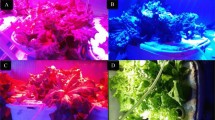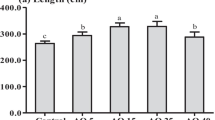Abstract
Vascular plant bio-photovoltaics (VP-BPV) is a recently developed technology that uses higher plants to harvest solar energy and the metabolic activity of heterotrophic microorganisms in the plant rhizosphere to generate electrical power. In the present study, electrical output and maximum power output variations were investigated in a novel VP-BPV configuration using the crop plant rice (Oryza sativa L.) or an associated weed, Echinochloa glabrescens (Munro ex Hook. f.). In order to compare directly the physiological performances of these two species in VP-BPV systems, plants were grown in the same soil and glasshouse conditions, while the bio-electrochemical systems were operated in the absence of additional energy inputs (e.g. bias potential, injection of organic substrate and/or bacterial pre-inoculum). Diurnal oscillations were clearly observed in the electrical outputs of VP-BPV systems containing the two species over an 8-day growth period. During this 8-day period, O. sativa generated charge ∼6 times faster than E. glabrescens. This greater electrogenic activity generated a total charge accumulation of 6.75 ± 0.87 Coulombs for O. sativa compared to 1.12 ± 0.16 for E. glabrescens. The average power output observed over a period of about 30 days for O. sativa was significantly higher (0.980 ± 0.059 GJ ha−1 year−1) than for E. glabrescens (0.088 ± 0.008 GJ ha−1 year−1). This work indicates that electrical power can be generated in both VP-BPV systems (O. sativa and E. glabrescens) when bacterial populations are self-forming. Possible reasons for the differences in power outputs between the two plant species are discussed.





Similar content being viewed by others
References
Badri DV, Loyola-Vargas VM, Broeckling CD, Vivanco JM (2010) Root secretion of phytochemicals in Arabidopsis is predominantly not influenced by diurnal rhythms. Mol Plant 3:491–498
Bain RL (2007) World biofuels assessment. Worldwide biomass potential: technology characterizations. National Renewable Energy Laboratory, Dept. of Energy, Golden, CO. NREL/MP. http://www.nrel.gov/docs/fy08osti/42467.pdf. Accessed 19 Jul 2012
Bais HP, Weir TL, Perry LG, Gilroy S, Vivanco JM (2006) The role of root exudates in rhizosphere interactions with plants and other organisms. Annu Rev Plant Biol 57:233–266
Bais HP, Broeckling CD, Vivanco JM (2008) Root exudates modulate plant–microbe interactions in the rhizosphere. In: Karlovsky P (ed) Secondary metabolites in soil ecology, 1st edn. Springer, Berlin, pp 241–252
Bombelli P, Bradley RW, Scott AM, Philips AJ, McCormick AJ, Cruz SM, Anderson A, Yunus K, Bendall DS, Cameron P, Davies J, Smith AG, Howe CJ, Fisher AC (2011) Quantitative analysis of the factors limiting solar power transduction by Synechocystis sp. PCC 6803 in biological photovoltaic devices. Energ Environ Sci 4:4690–4698
Bombelli P, Zarrouati M, Thorne RJ, Schneider K, Rowden SJL, Ali A, Yunus K, Cameron PJ, Fisher AC, Wilson DI, Howe CJ, McCormick AJ (2012) Surface morphology and surface energy of anode materials influence power outputs in a multi-channel mediatorless bio-photovoltaic (BPV) system. Phys Chem Chem Phys. doi:10.1039/C2CP42526B
Chen Z, Huang YC, Liang JH, Zhao F, Zhu YG (2012) A novel sediment microbial fuel cell with a biocathode in the rice rhizosphere. Bioresour Technol 108:55–59
De Schamphelaire LD, Bossche LVD, Dang HS, Hofte M, Boon N, Rabaey K, Verstraete W (2008) Microbial fuel cells generating electricity from rhizodeposits of rice plants. Environ Sci Technol 42:3053–3058
Delaney GM, Bennetto HP, Mason JR, Roller SD, Stirling JL, Thurston CF (1984) Electron-transfer coupling in microbial fuel cells: 1. Comparison of redox-mediator reduction rates and respiratory rates of bacteria. J Chem Technol Biotechnol 34:13–27
Dresselhaus MS, Thomas IL (2001) Alternative energy technologies. Nature 414:332–337
Du Z, Li H, Gu T (2007) A state of the art review on microbial fuel cells: a promising technology for wastewater treatment and bioenergy. Biotechnol Adv 25:464–482
Elsayed MA, Matthews R, Mortimer ND (2003) Carbon and balances for a range of biofuels options. Project number B/B6/00784/REP, URN 03/836. Sheffield Hallam University. http://www.rms.lv/bionett/Files/File/BioDE-2003-101%20DTI%20biodiesel%20LCA%20study.pdf. Accessed 19 Jul 2012
Farré EM, Weise SE (2012) The interactions between the circadian clock and primary metabolism. Curr Opin Plant Biol 15:1–8
Graystone SJ, Wang S, Campbell CD, Edwards AC (1998) Selective influence of plant species on microbial diversity in the rhizosphere. Soil Biol Biochem 30:369–378
Haydon M, Bell LJ, Webb AAR (2011) Interactions between plant circadian clocks and solute transport. J Ex Bot 62:2333–2348
Helder M, Strik DPBTB, Hamelers HVM, Kuhn AJ, Blok C, Buisman CJN (2010) Concurrent bio-electricity and biomass production in three plant–microbial fuel cells using Spartina anglica, Arundinella anomala and Arundo donax. Bioresour Technol 101:3541–3547
Helder M, Strik DPBTB, Hamelers HVM, Kuijken RCP, Buisman CJN (2012) New plant-growth medium for increased power output of the plant-microbial fuel cell. Bioresour Technol 104:417–423
Hubenova Y, Mitov M (2012) Conversion of solar energy into electricity by using duckweed in direct photosynthetic plant fuel cell. Bioelectrochem 87:185–191
IEA (2010) International Energy Agency, key world energy statistics. www.iea.org/textbase/nppdf/free/2010/key_stats_2010.pdf. Accessed 19 Apr 2012
IFPB (2008) Increasing feedstock production for biofuels: economic drivers, environmental implications, and the role of research, the biomass research and development board. http://www.usbiomassboard.gov/pdfs/8_Increasing_Biofuels_Feedstock_Production.pdf. Accessed 19 Jul 2012
IRRI (2012) International rice research institute: helps reduce global poverty & hunger by helping farmers grow more rice & keep people & the environment healthy. www.irri.org. Accessed 19 Jul 2012
Kaku N, Yonezawa N, Kodama Y, Watanabe K (2008) Plant/microbe cooperation for electricity generation in a rice paddy field. Appl Microbiol Biotechnol 79:43–49
Kim IS, Chae KJ, Choi MJ, Verstraete W (2008) Microbial fuel cells: recent advances, bacterial communities and application beyond electricity generation. Environ Eng Res 13:51–65
Logan BE, Hamelers B, Rozendal R, Schröder U, Keller J, Freguia S, Aelterman P, Verstraete W, Rabaey K (2006) Microbial fuel cells: methodology and technology. Environ Sci Technol 40:5181–5192
Lovley RD (2006) Microbial fuel cells: novel microbial physiologies and engineering approaches. Curr Opin Biotechnol 17:327–332
Luque R (2010) Algal biofuels: the eternal promise? Energ Environ Sci 3:254–257
McClung CR (2001) Circadian rhythms in plants. Annu Rev Plant Physiol Plant Mol Biol 52:139–162
McCormick AJ, Bombelli P, Scott AM, Philips AJ, Smith AG, Fisher AC, Howe CJ (2011) Photosynthetic biofilms in pure culture harness solar energy in a mediatorless bio-photovoltaic (BPV) cell system. Energ Environ Sci 4:4699–4709
Park DH, Laivenieks M, Guettler MV, Jain MK, Zeikus JG (1999) Microbial utilization of electrically reduced neutral red as the sole electron donor for growth and metabolite production. Appl Environ Microbiol 65:2912–2917
Phillips DA, Fox TC, Six J (2006) Root exudation (net efflux of amino acids) may increase rhizodeposition under elevated CO2. Glob Change Biol 12:561–567
Potter MC (1911) Electrical effects accompanying the decomposition of organic compounds. Proc R Soc London 81:465–480
Reguera G, McCarthy KD, Mehta T, Nicoll JS, Tuominen MT, Lovley DR (2005) Extracellular electron transfer via microbial nanowires. Nature 435:1098–1101
Roller SD, Bennetto HP, Delaney GM, Mason JR, Stirling JL, Thurston CF (1984) Electron-transfer coupling in microbial fuel cells: 1. Comparison of redox-mediator reduction rates and respiratory rates of bacteria. J Chem Technol Biotechnol 34:3–12
Rosenbaum M, Schröder U (2010) Photomicrobial solar and fuel cells. Electroanalysis 22:844–855
Strik DPBTB, Hamelers HVM, Snel JFH, Buisman CJN (2008) Green electricity production with living plants and bacteria in a fuel cell. Int J Energ Res 32:870–876
Strik DPBTB, Timmers RA, Helder M, Steinbusch KJJ, Hamelers HVM, Buisman CJN (2011) Microbial solar cells: applying photosynthetic and electrochemically active organisms. Trends Biotechnol 29:41–49
Takanezawa K, Nishio K, Kato S, Hashimoto K, Watanabe K (2010) Factors affecting electric output from rice-paddy microbial fuel cells. Biosci Biotechnol Biochem 74:1271–1273
Timmers RA, Strik DPBTB, Hamelers HVM, Buisman CJN (2010) Long-term performance of a plant microbial fuel cell with Spartina anglica. Appl Microbiol Biotechnol 86:973–981
Timmers RA, Rothballer M, Strik DPBTB, Engel M, Schulz S, Schloter M, Hamelers HVM, Buisman CJN (2012) Microbial community structure elucidates performance of Glyceria maxima plant microbial fuel cell. Appl Microbiol Biotechnol 94:537–548
Walker TS, Bais HP, Grotewold E, Vivanco JM (2003) Root exudation and rhizosphere biology. Plant Physiol 132:44–51
Williams PJLB, Laurens LML (2010) Microalgae as biodiesel & biomass feedstocks: review & analysis of the biochemistry, energetic & economics. Energ Environ Sci 3:554–590
Zou Y, Pisciotta J, Billmyre RB, Baskakov IV (2009) Photosynthetic microbial fuel cells with positive light response. Biotechnol Bioeng 104:939–946
Acknowledgments
The authors are grateful for funding provided by the UK Engineering and Physical Sciences Research Council (EPSRC), the Cambridge Commonwealth Trust, Commonwealth Scholarship Commission and Jawaharlal Nehru Memorial Trust.
Author information
Authors and Affiliations
Corresponding author
Additional information
PB and DMRI contributed equally to this work.
Electronic supplementary material
Below is the link to the electronic supplementary material.
ESM 1
(PDF 442 kb)
Rights and permissions
About this article
Cite this article
Bombelli, P., Iyer, D.M.R., Covshoff, S. et al. Comparison of power output by rice (Oryza sativa) and an associated weed (Echinochloa glabrescens) in vascular plant bio-photovoltaic (VP-BPV) systems. Appl Microbiol Biotechnol 97, 429–438 (2013). https://doi.org/10.1007/s00253-012-4473-6
Received:
Revised:
Accepted:
Published:
Issue Date:
DOI: https://doi.org/10.1007/s00253-012-4473-6




